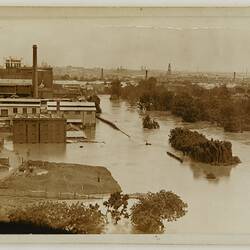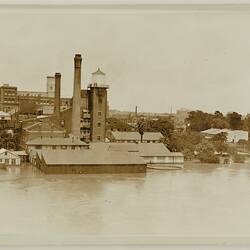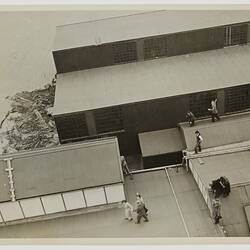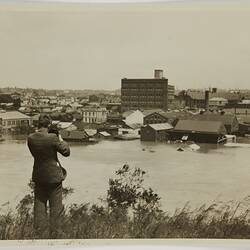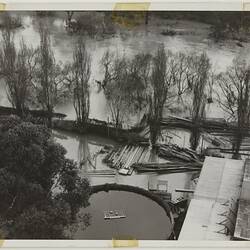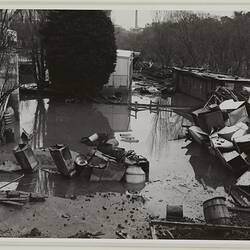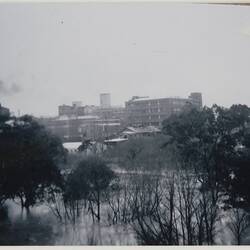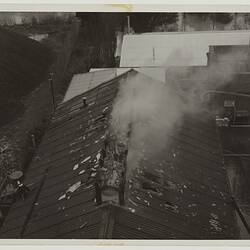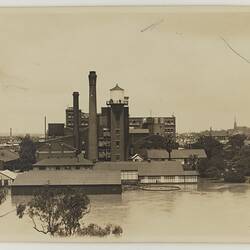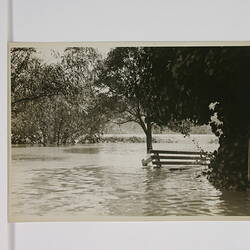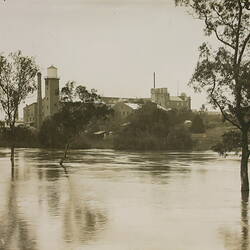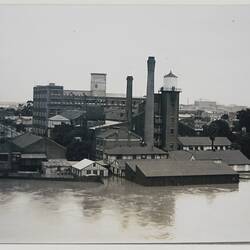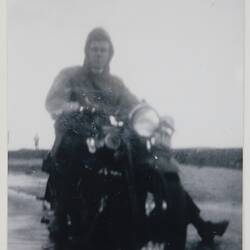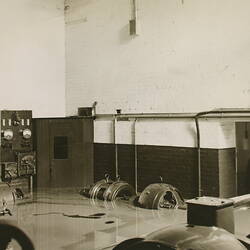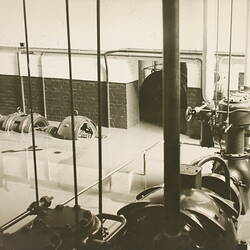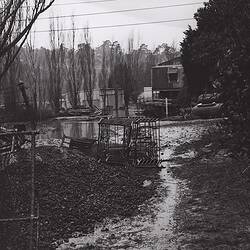Floods at Kodak Australasia's Abbotsford Factory - 1934 and 1952
November 1934
The Yarra River in Melbourne has experienced several major floods and being built on land leading down to the banks of the Yarra, the Kodak Australasia factory in Abbotsford was significantly impacted by at least two of these floods in the early to mid-twentieth century - the 1934 and 1952 flood events.
The first substantial flood after the European settlement of Melbourne was on Christmas Day in 1839, not long after settlement. Following this, several more major inundations were documented, the worst in December 1863 when a flood reached from Customs House in the city to Toorak Road. Subsequent floods in 1891, 1923 and 1934 were almost as extensive, causing widespread damage. Relief works were undertaken between these floods to realign and change the flow of the river to try to prevent further flood events.
In the November 1934 flood, the worst of Melbourne's twentieth century floods, the city experienced massive floods from a storm that also caused widespread flooding across the state of Victoria. According to newspaper reports, the Yarra River transformed into a lake that spread from South Yarra to Warrandyte.
The Kodak factory, which was situated in Abbotsford on a property with Yarra River frontage (the property was originally named Yarra Grange), was, not surprisingly, substantially affected. Other parts of Abbotsford were also affected, with one newspaper of the time reporting that over 200 people had to leave their homes.
At Kodak a number of the factory buildings were inundated, including the Powerhouse and maintenance workshops. A large tank used for silver recovery that was located near the river bank was also affected. The tank contained a slurry of silver nitrate. Silver nitrate was used in the manufacturing of photographic film products. It is a process where silver is dissolved in nitric acid.
A number of Kodak staff undertook inspections of the flooded factory site to check for damage. A group of men and women climbed onto the maintenance buildings near the river front to have a closer look at the flood waters, while some of the party also climbed the water tank tower at the back of the Paper Coating Department building, which would have afforded excellent views.
The plumbing foreman, Jim Myers, and another of his staff rowed a dinghy close to the silver recovery tank to assess the damage. The floods potentially had washed away into the river some of the materials and chemicals that were used in the manufacturing process, including the valuable silver, which was locked up in silver nitrate but could be recovered and re-used to make more film.
July 1952
On the 14th July 1952, Melbourne was once again struck by heavy rains and flooding. It was widely reported as the worst flood to affect the area since 1934. Houses and factories around the Yarra River were inundated by water, including the Kodak factory at Abbotsford which experienced 12 foot high flood waters.
But this time, while the water was lapping across the timber yard and carpenter's building, a fire was sweeping through the silver nitrate building. It is believed a spark from an electric drill started the fire which then swept through the building mid-morning. It damaged not only the building but all the silver nitrate solution housed in vats. Six employees were working in the building at the time the fire started, but luckily they escaped with only minor burns. The fire burned for 15 minutes but was quickly brought under control by the fire brigade.
The cost of the flood and fire was estimated to be around £12,000 which included the damage to the silver nitrate building and stocks of timber.
References
The Argus, 3 Dec 1934, pp.8-10
Encyclopedia of Melbourne, Tony Dingle and Andy Brown-May,'Yarra River', pp. 788-789; Tony Dingle, 'Floods and Drainage', p.274
"Film Plant Suffers by Fire; Floods" The Age, 15 July 1952, p.3
http://nla.gov.au/nla.news-article206217222
"FLOOD, THEN FILM BLAZE" The Herald, 14 July 1952, p.1
http://nla.gov.au/nla.news-article244377315
"Factory in fire and flood", News, 14 July 1952, p. 20
http://nla.gov.au/nla.news-article130808409
More Information
-
Keywords
-
Authors
-
Article types

